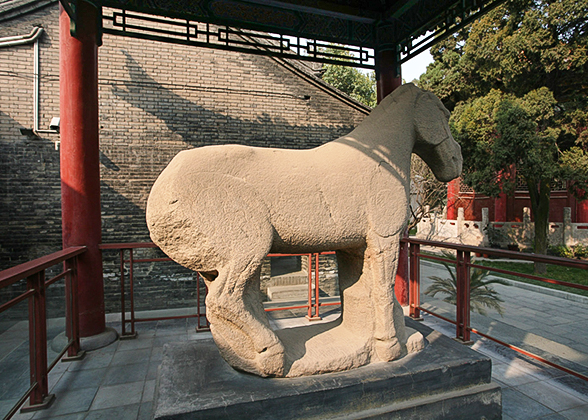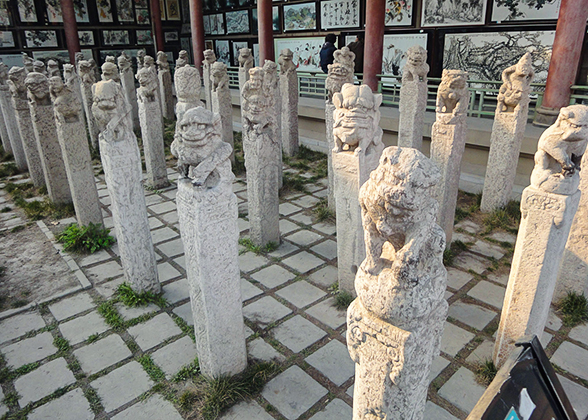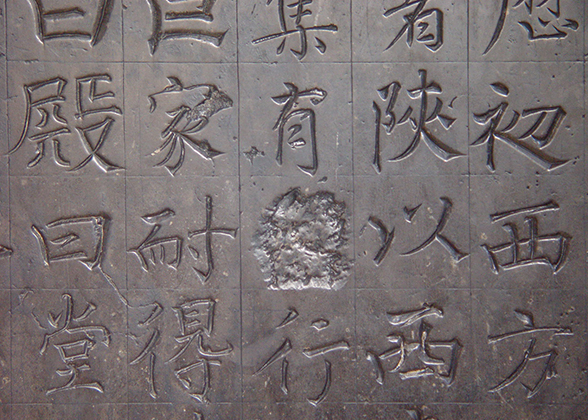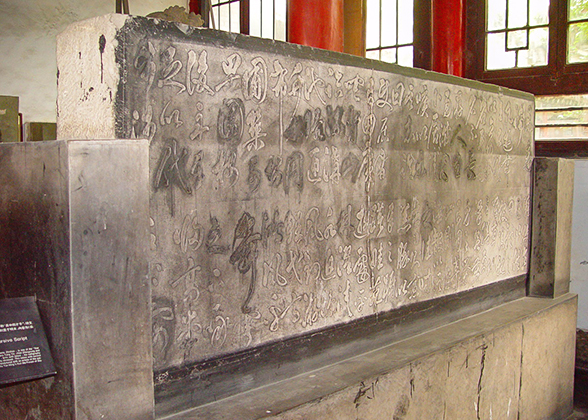Stele Forest - Beilin Museum
The Stele Forest, also called Beilin Museum, is a themed museum focusing on displays of stone steles, epigraphs and stone sculptures from past dynasties. Its location is on Sanxue Street, inside the Wenchang Gate of the Xi'an City Wall. Its construction is based on Xi'an Confucius Temple dating from 1087 during the North Song Dynasty (960 – 1127). The museum was built to preserve the Kaicheng Classics (a group of stone tablets) and the Filial Piety Classics. The collection has grown and now includes 11,000 relics, including three thousand stone steles or epigraphs that are housed in seven separate exhibition rooms. Among these many precious relics, there are 19 groups deemed to be national treasures that the visitor should not fail to see.![]() National Treasures in Stele Forest
National Treasures in Stele Forest
Compared with other museums, the outstanding characteristic of the Stele Forest is its collection of inscribed tablets. Tablet inscriptions tell us about the religions, life styles and historical facts of ancient times in a vivid way. They provide tourists with a grasp of the general outline of Chinese history and the interaction of China and other countries. For the fans of Chinese calligraphy, these inscriptions are of great interest as they are fine examples of the diverse styles of Chinese characters.
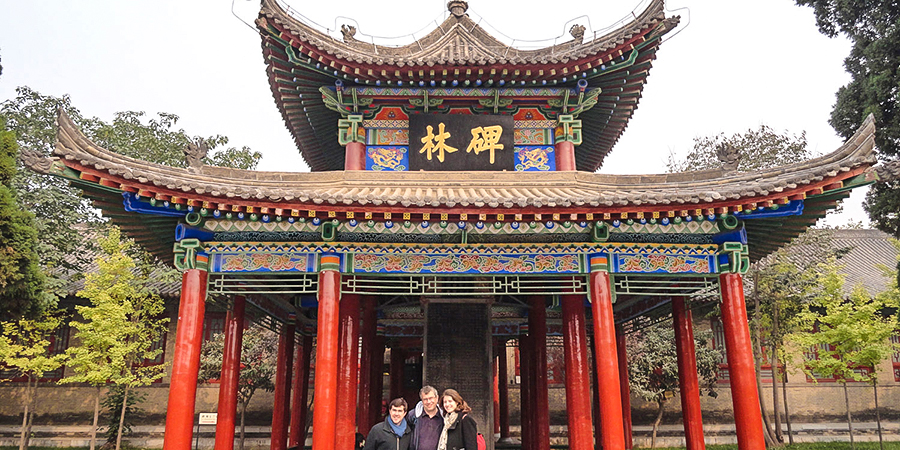 |
| Pavilion Housing the Stone Tablet of Classic of Filial Piety |
The Stele Forest is divided into two parts by the Halberd Gate, with the old constructions in the Confucius Temple in front and the exhibition rooms at the back. Upon arrival, the site of the Confucius Temple, including the screen wall, memorial archway and the Lingxing Gates, is before you. Through the Halberd Gate, two separate pavilions are arranged one on either side, with a stone horse of Daxia State (a minority ethnic state from 407 to 431) on the north side and a bell made in Tang Dynasty (618 - 907) on the south. The stone horse is a national treasure as it is rare and in the style of the Han Dynasty (206 BC - 220 AD).
As you go forward you pass by six pavilions and several temporary exhibition rooms arranged along a narrow path. At present, all these pavilions are closed to the public. At the end of this path there is a pavilion where the Stone Tablet of Classic Filial Piety is displayed. This was carved during the Tang Dynasty and bears inscription of dialogues between Confucius and his students.
|
|
Seven Exhibition Rooms for Steles
![]() The first room of Stele Forest is just behind the Stone Tablet of Classic of Filial Piety. The major exhibits in this room are the Kaicheng Classics, carved in 837 AD during the Tang Dynasty. This is a group of stone tablets with 12 reading books for intellectuals inscribed on them. Ancient Chinese people carved such books in stone to prevent copying errors and thereby provided models by which students could check the accuracy of reproduced texts. The Kaicheng Classics are the best preserved set of classics on stones in China.
The first room of Stele Forest is just behind the Stone Tablet of Classic of Filial Piety. The major exhibits in this room are the Kaicheng Classics, carved in 837 AD during the Tang Dynasty. This is a group of stone tablets with 12 reading books for intellectuals inscribed on them. Ancient Chinese people carved such books in stone to prevent copying errors and thereby provided models by which students could check the accuracy of reproduced texts. The Kaicheng Classics are the best preserved set of classics on stones in China.![]() Pictures of the First Room
Pictures of the First Room![]() The second room of Stele Forest collects stone tablets focusing on Chinese calligraphy of the Tang Dynasty. Most of these are examples used by those learning calligraphy today. The Nestorian Stele and the Bukong Monk Stele in this room are valuable sources for the study of intercultural communications between China and foreign countries during the Tang Dynasty.
The second room of Stele Forest collects stone tablets focusing on Chinese calligraphy of the Tang Dynasty. Most of these are examples used by those learning calligraphy today. The Nestorian Stele and the Bukong Monk Stele in this room are valuable sources for the study of intercultural communications between China and foreign countries during the Tang Dynasty.![]() Pictures of the Second Room
Pictures of the Second Room![]() In the third room, stone tablets of calligraphy in other dynasties from the Han Dynasty to the Song Dynasty (960 - 1279) are on display. These focus mainly on various styles of Chinese calligraphy such as seal characters and regular script. For instance, the Stone Tablet of Cao Quan focuses on the clerical script and the Duobao Pagoda Stele and Xuanmi Pagoda Stele are the representatives of the regular script.
In the third room, stone tablets of calligraphy in other dynasties from the Han Dynasty to the Song Dynasty (960 - 1279) are on display. These focus mainly on various styles of Chinese calligraphy such as seal characters and regular script. For instance, the Stone Tablet of Cao Quan focuses on the clerical script and the Duobao Pagoda Stele and Xuanmi Pagoda Stele are the representatives of the regular script.![]() Pictures of the Third Room
Pictures of the Third Room
|
|
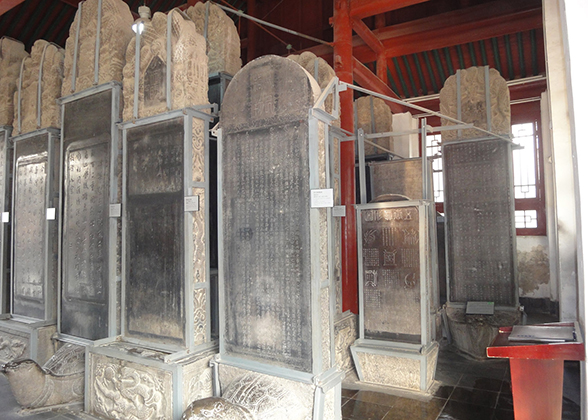 |
| Stone Steles of Ancient Dynasties |
![]() In the sixth room, most of the stone steles have poems, written in Qing Dynasty, carved on them, which are very hard to obtain. You can even see stone steles written by Emperor Kangxi, the fourth Qing Dynasty emperor, and Lin Zexu, a national hero of the Qing Dynasty.
In the sixth room, most of the stone steles have poems, written in Qing Dynasty, carved on them, which are very hard to obtain. You can even see stone steles written by Emperor Kangxi, the fourth Qing Dynasty emperor, and Lin Zexu, a national hero of the Qing Dynasty.![]() Pictures of the Sixth Room
Pictures of the Sixth Room![]() In the last room of Stele Forest, the seventh is where a replica of The Secret Copybooks of Chunhua is kept. The original Secret Copybooks of Chunhua, engraved in the year of Chunhua (992 AD) during the Song Dynasty, was a group of date-wood boards bearing calligraphy written by emperors, famous ministers and other skilled calligraphers. These copybooks were destroyed in a fire. Later during 1615 AD in the Ming Dynasty (1368 - 1644), new carvings based on the rubbings of the originals were made and these now shown in this room.
In the last room of Stele Forest, the seventh is where a replica of The Secret Copybooks of Chunhua is kept. The original Secret Copybooks of Chunhua, engraved in the year of Chunhua (992 AD) during the Song Dynasty, was a group of date-wood boards bearing calligraphy written by emperors, famous ministers and other skilled calligraphers. These copybooks were destroyed in a fire. Later during 1615 AD in the Ming Dynasty (1368 - 1644), new carvings based on the rubbings of the originals were made and these now shown in this room.
Stone Sculpture Art Galleries
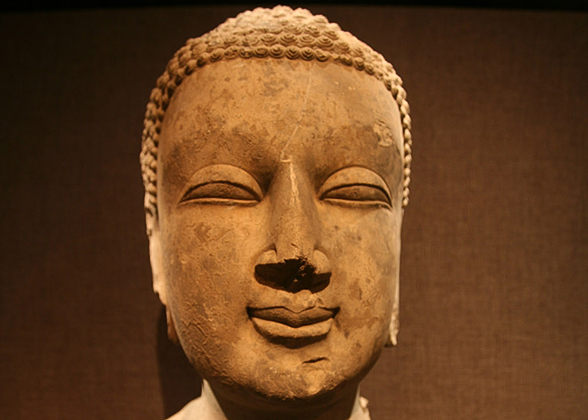 |
| Buddha's Head in Stone Sculpture Art Galleries |
The older hall, showing about 70 exquisite exhibits dating from the Han and Tang Dynasties, is on the west. It is divided into two parts, namely stone sculptures from tombs and those about religion. Among the sculptures from tombs, the epigraph from Li Shou (a general as well as the brother of first emperor of Tang Dynasty) is the most famous, because it is the only one that exists in China. Also, the Six Steeds from the Zhaoling Mausoleum is outstanding. These represent Emperor Taizong’s favorite horses, which were engraved on the stone and put into his tomb after his death. The images of Buddhist statues of Sui (581 - 618) and Tang Dynasties are diverse. Embossments as well as circular engravings reflect the condition and development of Buddhism in ancient China
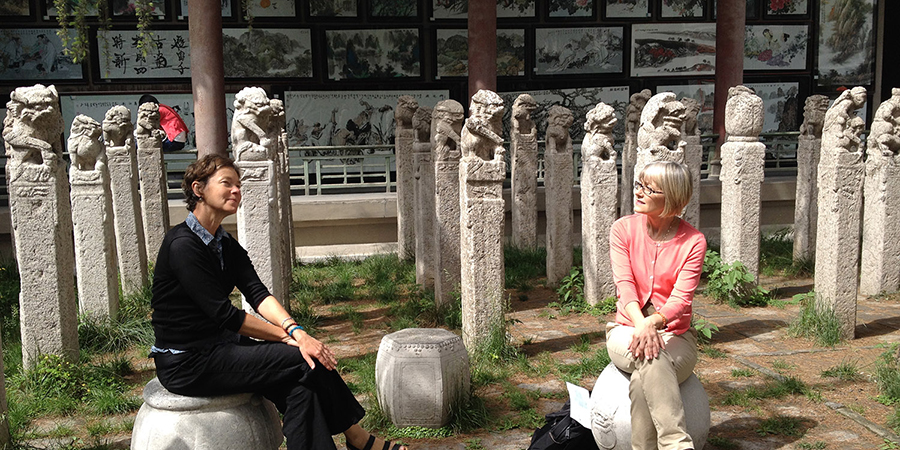 |
How to get to Stele Forest
Or take metro line 2 to Yongningmen and take Exit D1, walk north for 400 meters (437 yards), turn right and walk along South Shuncheng Rd. to find the museum.
Xi'an Bus /Metro Search
| Entrance Fee | March to November: CNY 65 December to the next February: CNY 50; * Children under 1.2 meters are free of charge. * A combo ticket for this museum and Xi'an City Wall costs CNY 100. |
|---|---|
| Opening Hours | 9:00 - 17:30 (stop admission at 17:00) * Tickets selling stops 45 minutes earlier. |
| Recommended Time for a Visit | Three hours |
![]() Nearby Attractions: Xi'an City Wall Shuyuanmen Ancient Cultural Street
Nearby Attractions: Xi'an City Wall Shuyuanmen Ancient Cultural Street
